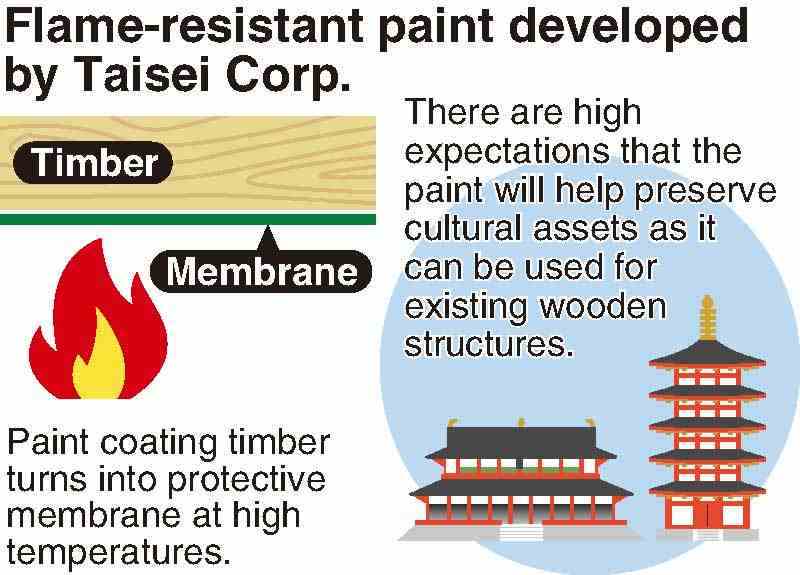
11:51 JST, June 5, 2022
Taisei Corp., a major general construction contractor, has developed special paint that makes wood less flammable with a simple application to the surface of the timber.
A technology that improves fire resistance without dismantling existing wooden structures is rare and expected to be used for the preservation of cultural assets.
Taisei discovered that when wood is coated with paint containing resins and flame-retardant chemicals, a thin membrane is created, and this membrane significantly slows combustion at high temperatures. The company has turned the discovery into a paint product. Tests conducted by an external evaluating organization showed that wood coated with the paint met the standard approved by the Land, Infrastructure, Transport and Tourism Ministry for so-called quasi-incombustible materials that do not burn even after being exposed to a fire for 10 minutes.
Conventional flame-resistant technology requires wood to be placed in a special device and pressure applied to allow a chemical to penetrate the inside of the wood. To use such a technology on existing wooden structures, the structures must be disassembled into lumber and then sized to fit into the device. In addition to the high cost, this technique cannot be used for many historical buildings.
“It is easy to apply, and it helps buy time before a wooden structure starts to burn,” said a Taisei employee in charge of the development of the paint. “This increases the possibility one will be able to prevent the structure from burning down.”
The paint can be used not only for cultural assets but also for general architectural structures, such as wooden buildings, for which demand has increased amid a trend toward decarbonization, and existing condominiums and houses that are to be renovated.
The company plans to first use the paint for its construction projects and will consider selling it in the future.
"Business" POPULAR ARTICLE
-

Keidanren Chairman Yoshinobu Tsutsui Visits Kashiwazaki-Kariwa Nuclear Power Plant; Inspects New Emergency Safety System
-

Imports of Rare Earths from China Facing Delays, May Be Caused by Deterioration of Japan-China Relations
-

University of Tokyo Professor Discusses Japanese Economic Security in Interview Ahead of Forum
-

Japan Pulls out of Vietnam Nuclear Project, Complicating Hanoi’s Power Plans
-

Govt Aims to Expand NISA Program Lineup, Abolish Age Restriction
JN ACCESS RANKING
-

Keidanren Chairman Yoshinobu Tsutsui Visits Kashiwazaki-Kariwa Nuclear Power Plant; Inspects New Emergency Safety System
-

Imports of Rare Earths from China Facing Delays, May Be Caused by Deterioration of Japan-China Relations
-

University of Tokyo Professor Discusses Japanese Economic Security in Interview Ahead of Forum
-

Japan Pulls out of Vietnam Nuclear Project, Complicating Hanoi’s Power Plans
-

Govt Aims to Expand NISA Program Lineup, Abolish Age Restriction























